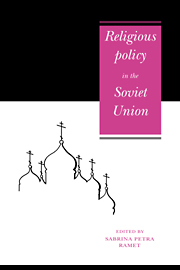Book contents
- Frontmatter
- Contents
- Notes on contributors
- Preface
- Part I Introduction
- Part II Policy apparatus
- Part III Education, socialisation, and values
- Part IV Cults and sects
- Part V The world of Christianity
- 12 The Russian Orthodox Renovationist Movement and its Russian historiography during the Soviet period
- 13 The re-emergence of the Ukrainian (Greek) Catholic Church in the USSR
- 14 Protestantism in the USSR
- 15 Epilogue: religion after the collapse
- APPENDIX: Religious groups numbering 2,000 or more, in the USSR
- Index
13 - The re-emergence of the Ukrainian (Greek) Catholic Church in the USSR
Published online by Cambridge University Press: 03 December 2009
- Frontmatter
- Contents
- Notes on contributors
- Preface
- Part I Introduction
- Part II Policy apparatus
- Part III Education, socialisation, and values
- Part IV Cults and sects
- Part V The world of Christianity
- 12 The Russian Orthodox Renovationist Movement and its Russian historiography during the Soviet period
- 13 The re-emergence of the Ukrainian (Greek) Catholic Church in the USSR
- 14 Protestantism in the USSR
- 15 Epilogue: religion after the collapse
- APPENDIX: Religious groups numbering 2,000 or more, in the USSR
- Index
Summary
In April 1945, Joseph Stalin ordered the arrest, trial, and imprisonment of all the bishops and thousands of priests, monastics and laity of the Greek Catholic Church of Ukraine (today known in the West as the Ukrainian Catholic Church). The then primate of the church recalled:
On April 11, 1945 I was arrested together with all the other bishops. Within a year more than 800 priests followed us into imprisonment. From the 8th to the 10th of March 1946 the illegal synod of Lviv was convened and under atheistic pressure announced the ‘reunion’ of the Ukrainian Catholic Church with the Soviet controlled Orthodox Church.
Within a year the largest non-Roman, Catholic Church was officially liquidated. A church with ten bishops, 3,470 clergy, 1,090 nuns and over four million faithful became the largest illegal Christian community in the world. For almost forty-five years Greek Catholics were forced to hide their religious convictions, or feign Orthodoxy, or endure arrest, fines, even imprisonment. On 1 December, 1989 that persecution officially ended with the announcement by N. Kolesnick, chair of the Ukrainian Council for Religious Affairs, that Greek Catholic communities would be allowed to register with the authorities.
The change in Soviet policy towards the Greek Catholics is indicative of the depth of transformation in the policies of the USSR. For years the Greek Catholics were not tolerated because of their ties with the Vatican, their nationalism, and their religious beliefs. In the 1980s Soviet attitudes to all of these have changed dramatically, with profound consequences to the resurgent Greek Catholic Church.
- Type
- Chapter
- Information
- Religious Policy in the Soviet Union , pp. 292 - 318Publisher: Cambridge University PressPrint publication year: 1992
- 1
- Cited by

